- For over 30 years, Mark Erdmann has combined scientific discovery with grassroots conservation in Indonesia, helping communities protect their reefs from destructive practices and documenting more than 220 new species.
- As a leader behind Raja Ampat’s pioneering community-governed marine protected areas, Erdmann has shown how local stewardship can revive ecosystems—bringing back sharks, rays, and sustainable tourism.
- Despite new threats like over-tourism and revived mining, Erdmann remains hopeful, pointing to rising public resistance, tech-enabled rewilding programs like ReShark, and a new generation of Indonesian conservationists.
- Erdmann spoke with Mongabay Founder and CEO Rhett Ayers Butler during a voyage in the Pacific in June 2025.
For more than three decades, Mark Erdmann has worked where many only dream of diving—on the reefs and in the tangled mangroves of Indonesia’s farthest reaches. A marine biologist by training and a conservationist by necessity, Erdmann has spent much of his life documenting new species, persuading local communities to back marine protection, and fighting off the encroachment of extractive industries. His career, by his own account, has spanned more than 220 species discoveries, a handful of close encounters with crocodiles, and the creation of a new model for shark rewilding.
Erdmann’s journey began in a remote island village off the coast of South Sulawesi in 1991, where he arrived as a Ph.D. student studying coral reef ecology. His neighbors, he quickly realized, were bomb fishers and shark finners. The shift from science to action was swift.
“It was clear that more than science was needed; active protection was critical,” he recalls.
That realization became a life’s work. As Vice President of Asia-Pacific Marine Programs at Conservation International and now Executive Director of ReShark and Shark Conservation Director at Re:wild, Erdmann has been at the forefront of efforts to transform marine protection from a top-down regulatory exercise to a bottom-up, community-owned endeavor. Few places showcase this as clearly as Raja Ampat, the archipelago off West Papua that has become the crown jewel of Indonesian marine conservation.

When Erdmann first visited Raja Ampat in 2001, the coral reefs were ravishing—but so were the threats. Shark finners, bomb fishers, and cyanide divers crowded bay after bay. Working closely with local communities, Erdmann and his colleagues helped establish a network of marine protected areas (MPAs) governed not from Jakarta but from the villages themselves.
“They would set the rules, conduct the patrols, and we would help fund the infrastructure to make it happen,” he says.
The strategy worked. Fish returned. Sharks and manta rays rebounded. Tourism, once almost nonexistent, flourished.
But success brings complications. Over 100 liveaboard dive vessels now ply the waters, far exceeding the original cap of 40. Waste and congestion have become pressing concerns. Worse still, a recent shift in Indonesian governance stripped local regents of MPA authority, centralizing it at the provincial level.
“Now we’re back to square one—training new officials,” Erdmann says.
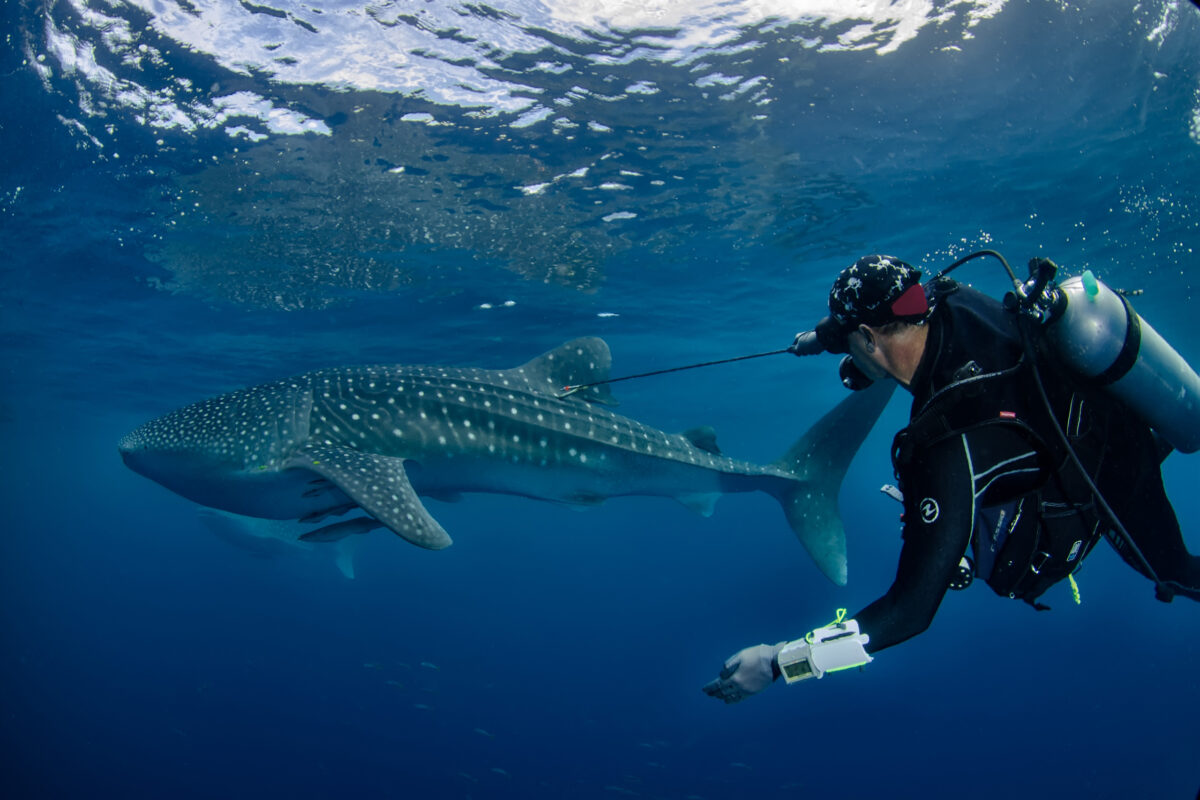
Mining has also resurfaced as a threat. Nickel extraction, once banned in Raja Ampat, reappeared during the pandemic. Yet here, too, the public showed unexpected resolve. A viral Greenpeace report sparked national outrage, prompting the Indonesian president to revoke four mining licenses.
“It showed that the Indonesian public doesn’t want to see Raja Ampat destroyed by mining,” says Erdmann.
If community buy-in remains Raja Ampat’s superpower, technology is becoming its new tool. To ensure that rewilded leopard sharks survive post-release, Erdmann’s ReShark program implants them with acoustic tags and tracks their movements across a grid of receivers. Nearly 50 have been released so far, with 80 more expected this year.
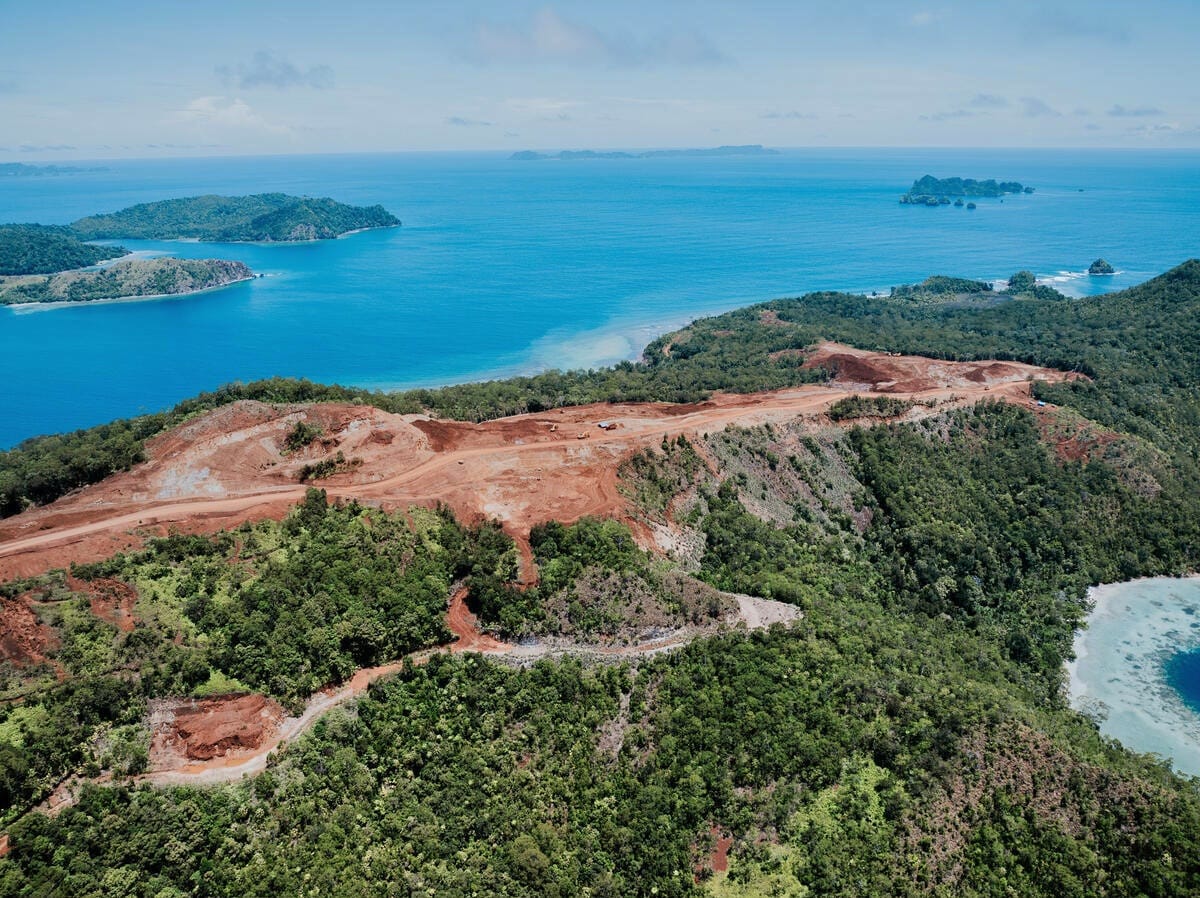
It’s a striking reversal of fortune for a species that had all but vanished from local waters. And Erdmann is betting that such efforts can go global: ReShark has already expanded to Thailand, with plans to rewild other threatened species—including the bowmouth guitarfish and the short-tailed nurse shark—in the pipeline.
Despite the setbacks, Erdmann remains a self-described “ocean optimist.” Part of that, he says, is due to Indonesia’s rising generation of conservationists—multilingual, tech-savvy, and passionate. The reefs, too, offer reason for hope. Though Raja Ampat did not escape the record-breaking 2023–24 coral bleaching event, many of its reefs appear to be bouncing back, bolstered by corals already adapted to dramatic thermal swings.
“The ocean can come back if we let it,” Erdmann says.
His life suggests that, in some corners of the planet, it already has.
Note: This interview has been edited for clarity and flow.
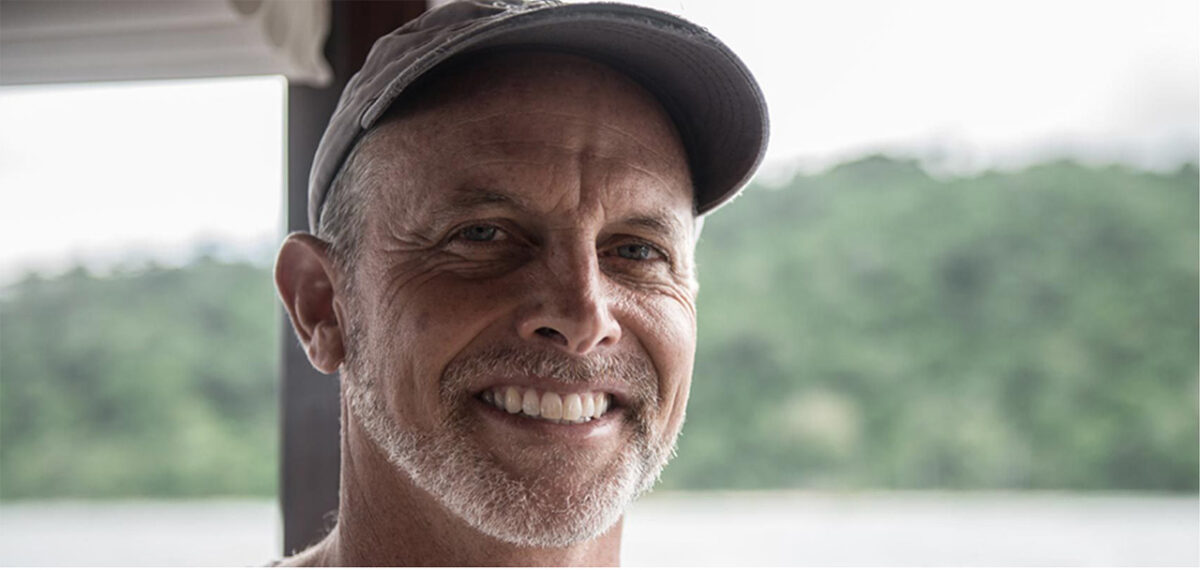
An interview with Mark Erdmann
Mongabay: What’s your name, your title, and where do you work?
Mark Erdmann: My name is Mark Erdmann. I’m currently the Executive Director of ReShark and also the Shark Conservation Director for Re:wild, though I recently finished a 20-year stint as Vice President of Asia-Pacific Marine Programs at Conservation International.
For the past 35 years, my main area of work has been the western Pacific, and eastern Indonesia in particular.
Mongabay: How did you get started in conservation?
Mark Erdmann: I moved to Indonesia in 1991 to do my Ph.D. research through UC Berkeley, basing myself on a small fishing village island offshore of Makassar, South Sulawesi. As I began my research on coral reef ecology, I soon realized that many of my neighbors were bomb fishers and shark finners. This realization had a profound impact on me and eventually shifted my focus—what started as a purely academic research pursuit evolved into a commitment to conservation. It was clear that more than science was needed; active protection was critical.
Mongabay: What first sparked your interest in nature and wildlife?
Mark Erdmann: It’s a bit of a cliché, but I wanted to be a marine biologist since I was knee-high to a grasshopper.

I grew up spending my summers on the Florida coastline and watching Jacques Cousteau documentaries and was hooked from an early age. Honestly, I think I was declaring I’d be a marine biologist by the time I was three.
Mongabay: And what is it about the ocean that draws you in?
Mark Erdmann: You’ve probably heard this before, but we still know less about the ocean than we do about the surface of the Moon. There’s so much left to discover. Over the course of my career, I’ve been fortunate to come across more than 220 new species—that gives you a sense of just how vast and full of wonder the ocean still is. It’s the cradle of life and home to the most biodiversity on Earth. You simply can’t get bored studying the ocean!
Mongabay: When did your career begin?
Mark Erdmann: I did my undergrad at Duke University, where I spent time at the Duke Marine Lab. I started my Ph.D. at Berkeley in 1990, and my fieldwork took me to Indonesia. I was based in South Sulawesi, around the islands of Barang Lompo off Makassar and Hoga and Kaledupa in the Wakatobi region. I ended up spending four and a half years there—not just doing research but also getting deeply involved in conservation, because the reefs were both spectacular and under serious threat. That combination really shaped my trajectory.
Mongabay: What does your day-to-day look like now?
Mark Erdmann: It’s incredibly varied. I do spend a fair amount of time fundraising, which often involves taking donors on trips to places like Raja Ampat and West Papua—places where they can fall in love with the ecosystems we’re trying to protect. But I still get to do a lot of the science and fieldwork that I love as well.
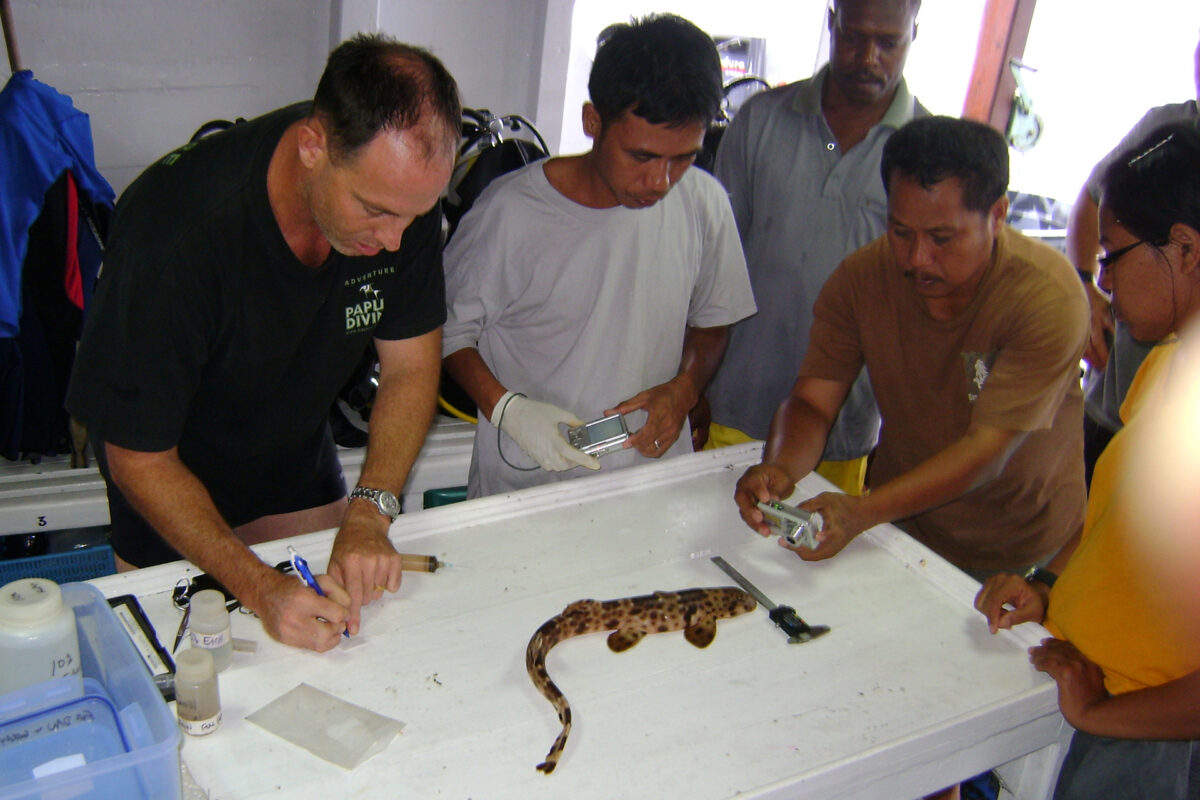
I still get to conduct a fair few marine biodiversity surveys and a lot of shark and ray-focused research, particularly satellite and acoustic telemetry work to study their movement ecology. These days, with the ReShark program, I also spend a lot of time in Raja Ampat working at our shark nurseries, where we’re hatching and releasing leopard sharks back into the wild. And I mentor six Ph.D. students, which I find deeply rewarding.
Mongabay: What’s your current geographic scope?
Mark Erdmann: Until recently with Conservation International, my scope spanned the Asia-Pacific region—places like New Caledonia, New Zealand, Australia, Indonesia, Papua New Guinea, Samoa, and Fiji.

Now with ReShark and Re:wild, these areas will remain central to my work, but we’re aiming to go fully international. We’ve already launched a project in Thailand, where we’re working with leopard sharks as well. The broader goal is to scale the shark rewilding model to other parts of the world where threatened species of sharks and rays exist—places where we can breed them in public aquaria and then reintroduce them to the wild. Potential expansion sites include Africa, Tasmania, and beyond.
Mongabay: What has changed the most in your work in Raja Ampat over the years?
Mark Erdmann: There are probably three major changes—some good, some not so good.
First, on the positive side, it’s been incredible to see the rise in quality and capacity of young conservationists in Indonesia. When I first started working there, it was difficult to find people with strong English skills and experience in community engagement or conservation. Now, there are so many talented Indonesians in their twenties who are exceptional at conservation and outreach, and who speak perfect English and have a good scientific background. It gives me a lot of hope for the future.
Second, something more concerning: when we started our work in Raja Ampat, it was during the heyday of decentralization in Indonesia. The regency had a lot of autonomy—it could establish and manage its own marine protected areas (MPAs), govern local resources, and make conservation decisions. But since 2014, there’s been a significant shift toward recentralization. Some authority has moved to the provincial level, and some back to the national government. From a natural resources management perspective, this isn’t ideal. For example, the Raja Ampat government can no longer manage its own MPAs—that’s now the responsibility of the provincial government.

The problem is, we spent over a decade training local government staff in MPA management, while the provinces, for the most part, didn’t develop the same capacity. So now we’re back to square one—having to train a new group of officials at the provincial level on how MPAs function and why they matter. That’s been frustrating.
That said, I am encouraged by the current leadership in West Papua and Southwest Papua. We have conservation-friendly governments in both regions, and I’m optimistic about the direction things are headed, even if the process has been bumpy.
The third major change is tourism. In some ways, we’ve become victims of our own success. In the early 2000’s, we advocated for marine tourism to become a major economic driver for the region. And while we haven’t reached the level of over-tourism you see in Bali or Komodo, Raja Ampat is heading in that direction—and that’s not what we intended.
Back in 2009, when the Raja Ampat government still had jurisdiction over its MPAs, we set limits on tourism growth. For example, we capped the number of liveaboard dive vessels at 40. Today, that number has ballooned to over 100. It’s not that Raja Ampat can’t handle that many boats—it’s that they’re not being managed or distributed properly. Most of them are clustering at the same few dive sites, creating congestion we never envisioned.
So now, tourism management is a top priority. We’re not just talking about crowding—it’s also issues like wastewater from homestays and boats, solid waste management, plastic pollution. We need to re-establish firm limits and develop a comprehensive management strategy.
Mongabay: What are some other conservation threats in the region?
Mark Erdmann: West Papua is incredibly rich in mineral resources, and that’s become a major concern—especially in Raja Ampat. Back in 2008–2009, a strong coalition of NGOs and local community leaders successfully lobbied the government to halt all nickel mining operations in the region, except two on Gag and Manoram Islands. We thought we’d established strong enough regulations to prevent mining from coming back.
Unfortunately, during the COVID years, nickel mining resurged. There was nothing in place to stop it initially. But just recently, we saw a major victory. Greenpeace released a report that went viral in Indonesia, calling out the mining activities in Raja Ampat. What’s amazing is the response—it triggered an outpouring of public support for protecting Raja Ampat, especially from young Indonesians on social media who are increasingly conservation-minded.

And just last night, the president revoked four mining licenses in the region. That was a huge win. Of course, we can’t be complacent—these things tend to come back. But it showed that the Indonesian public doesn’t want to see Raja Ampat destroyed by mining, and the government heard that message loud and clear.
Mongabay: What about threats from commercial fishing or foreign fleets?
Mark Erdmann: Fishing was one of the top issues when we started working in Raja Ampat in the early 2000s. Bomb fishing, in particular, was a major concern. I’m proud to say that we’ve largely eliminated it. It still happens occasionally—we know of one village where it continues—but it’s no longer happening inside the MPAs. And when it does occur, people are still being prosecuted.

Commercial fishing has also been largely addressed through the creation of nine large MPAs that exclude large-scale commercial operations. Occasionally, we see incursions by foreign vessels—Vietnamese or Cambodian shark-finners, Filipino purse seiners—but each MPA has its own patrol unit. Maybe twice a year, a vessel gets caught and prosecuted. So overall, I’d say fisheries are no longer the primary concern in Raja Ampat.
The bigger issues now are land-based: tourism-driven impacts, mining, and rapid population growth, especially in Waisai, the capital city.
Mongabay: How is community buy-in for conservation? Is the bottom-up approach still working?
Mark Erdmann: Absolutely. Raja Ampat is a textbook case of successful bottom-up conservation, and that was by design. Many of us working on Raja Ampat conservation had experience elsewhere in Indonesia, where top-down national park designations landed on communities without consultation—creating tension, resentment, even active resistance.
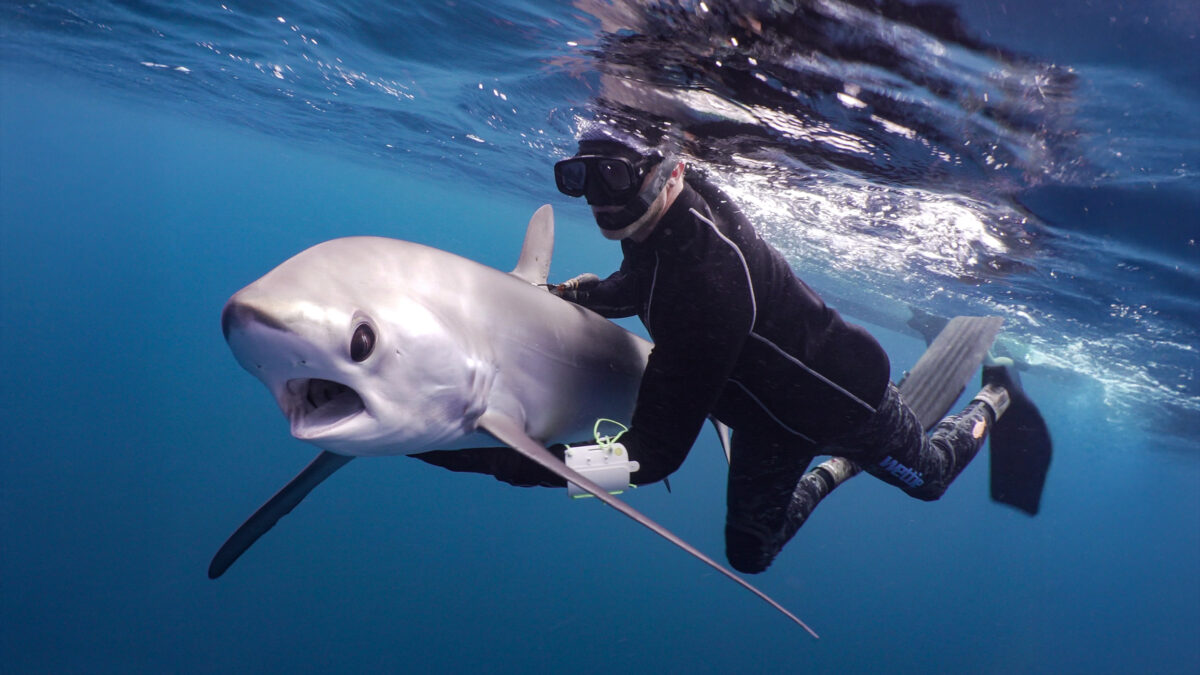
So when we began in Raja Ampat, we made a conscious decision: instead of walking in and pitching MPAs, we started by asking communities what they cared about. What were their biggest concerns?
Unsurprisingly, they talked about healthcare and education. But they also voiced serious concerns about food security. Outside fishing fleets from Sulawesi, bomb fishing, shark-finning—all of those were undermining their ability to feed their families. That’s where the door to marine protection opened.
These communities had been dealing with outside fishing fleets coming in for years. It got to the point where casting a line off your jetty no longer guaranteed you a catch. People had to paddle 5-10 kilometers offshore just to find fish. That caused a lot of concern.
When we approached them, we said, “Look, we think we have a solution.” A foundation of large-scale marine protected areas (MPAs), managed by the communities themselves. They would set the rules, conduct the patrols, and we would help fund the infrastructure to make it happen. These MPAs would become the basis for sustainable fisheries and marine tourism, and most importantly, they would keep outside fishers out.
The communities were incredibly receptive. It was probably the fastest turnaround I’ve ever seen when it comes to community support for MPAs. Almost immediately, six large MPAs were declared through adat—traditional declaration. Around that time, we had Indonesia’s first Papuan Minister of Fisheries, Freddy Numberi, who was very supportive and helped convert those adat declarations into formal legal recognition.
One of the key advantages of working during that era of decentralization was that the communities got to decide the zoning rules. They decided where the no-take zones would be, what kinds of fishing would be allowed where, and who could fish in those areas. They were also hired as park managers and patrol rangers.
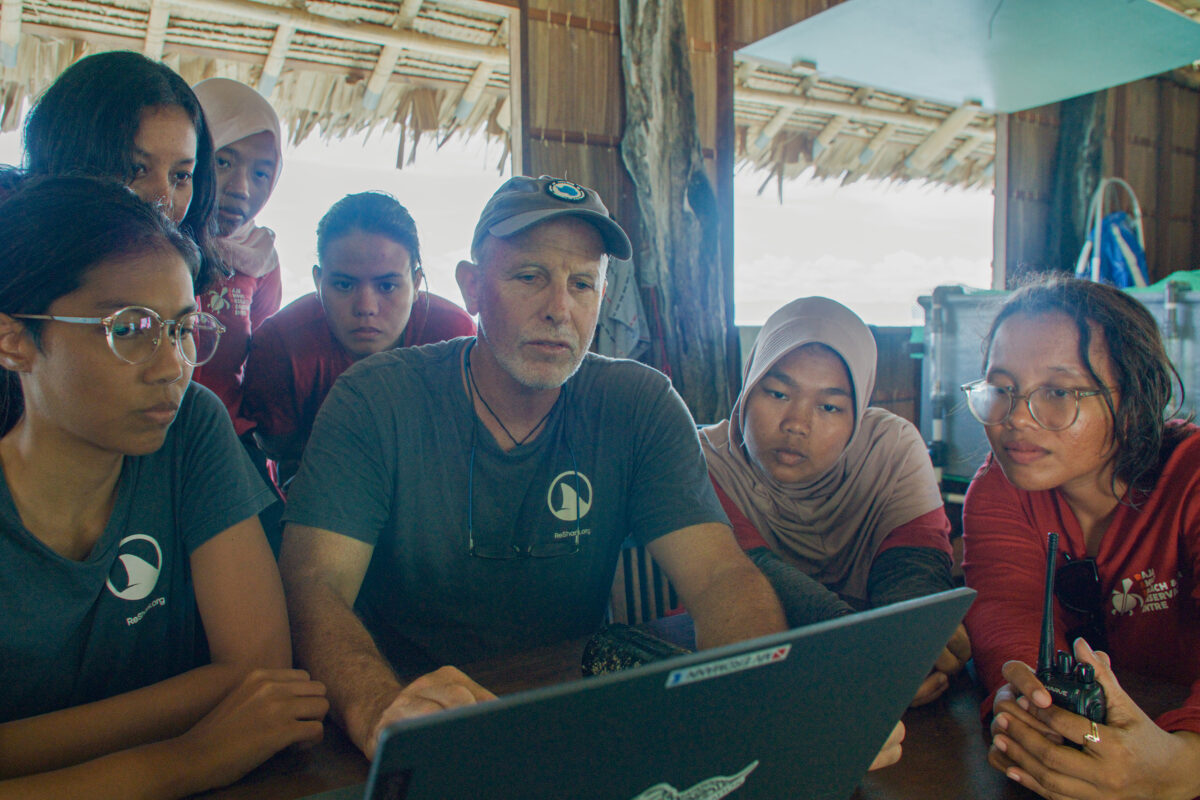
We established a quasi-governmental marine park management authority, which collects entrance fees—currently about $2.3 million a year. That revenue funds patrols and park operations. It’s not perfect, but overall, I’d say the model has been highly successful. Communities remain very supportive of both the MPAs and tourism.
What was fascinating during COVID was how people who had moved into tourism livelihoods had to revert to fishing and farming when tourism collapsed. What they found was astonishing: they could catch fish right in front of their villages again, without much effort. And importantly, they were still respecting the no-take zones. That wasn’t the case back in 2003 when we first started this work. In a strange way, the pandemic became proof of concept: people saw firsthand that the MPAs were delivering food security. That was always our goal—not just global biodiversity protection, but real, tangible benefits for local people and their grandchildren.
Mongabay: There was a story that came out after the pandemic about communities banding together to protect sharks. What happened there?
Mark Erdmann: Ah yes, that was in Raja Ampat.
Back in 2011, Misool Eco Resort lobbied the Raja Ampat government to establish a shark and ray sanctuary across the entire regency. That idea had strong community support. By then, people had already seen that manta rays were a top tourism draw, and tourists were always asking: “Where are the sharks?”
So, in 2011, we got a regency decree—pushed initially by Misool Resort—that established the sanctuary. Conservation International (CI) and The Nature Conservancy (TNC) then took that decree and worked it through the proper legislative process, turning it into a full-fledged Raja Ampat law. It became Southeast Asia’s first official shark and ray sanctuary.
We were later able to use that success to push for national-level protection for manta rays. It was a great example of bottom-up policy influencing national legislation.

Today, the average person in Raja Ampat knows that sharks and rays are essential to tourism. Since the sanctuary was established, reef shark populations have rebounded significantly. Manta rays are doing even better—we’re seeing annual population growth rates of 8–10%, which is the highest documented anywhere in the world. The communities are very proud of that.
The incident you mentioned happened after COVID, when some outside shark-finners came into the area. The local communities were outraged and immediately acted. Those fishers were arrested. It was a great example of how deeply conservation values are embedded now—they know how important these animals are for their livelihoods.
That momentum has also helped us launch something I’m deeply involved with now: the ReShark initiative.
The MPAs and shark sanctuaries have been highly successful at helping species like reef sharks and mantas recover, but some species haven’t bounced back—mainly because their populations were so decimated that recovery isn’t happening naturally. A great example is the leopard shark.
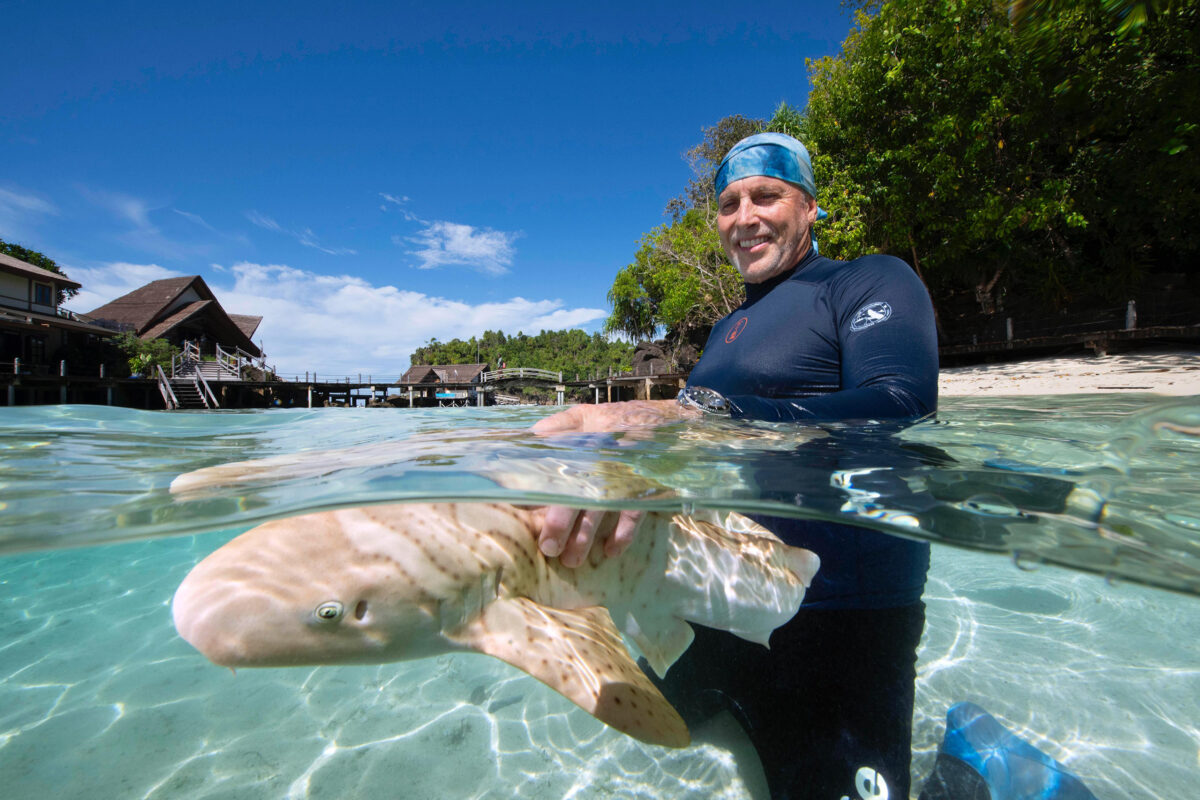
We launched ReShark to focus on rewilding threatened species like the leopard shark. Public aquariums around the world are quite good at breeding them in captivity. Working closely with our aquarium partners, eggs are collected and shipped to Raja Ampat, where we hatch them in two local nurseries. The juveniles are raised in sea pens until they’re about a meter long, and then we release them into the wild.
This was a bit of a moonshot idea I had back in 2015, but it’s gained real traction. We’ve already released nearly 50 leopard sharks, and we expect to release another 80 this year. Our goal is to put 500 into Raja Ampat’s waters over time, which will ensure a full population recovery.
It’s been so successful that we’ve expanded the program to Thailand, and we’re planning to scale it further. We’re looking at other species too—like the critically endangered bowmouth guitarfish and the short-tailed nurse shark—and designing similar rewilding efforts. The reality is that MPAs and fisheries regulations alone aren’t enough for some species. In those cases, active rewilding may be our only option.
Mongabay: When I was in Raja Ampat, Max Ammer was talking about efforts to track sharks. Can you talk about how technology is being used for that?
Mark Erdmann: Sure. In any reintroduction program—especially those done on land—post-release monitoring is absolutely essential. These programs are expensive and logistically complex, and the last thing you want is to release animals only to have them caught and killed immediately or fall prey to predators.
The IUCN has clear guidelines on this: if you’re doing a reintroduction, one of the top requirements—aside from avoiding genetic pollution—is proving the animals are actually surviving after release. On land, that’s fairly straightforward. You can put a radio collar or satellite tag on an African wild dog or California condor. But doing that in the ocean, especially with sharks, is much harder.

For ReShark, we’re using acoustic telemetry. Once our leopard shark pups reach about 80 centimeters in length, we surgically implant an acoustic transmitter into their body cavity. These tags have batteries that last five to six years.
We’ve installed a network of acoustic receivers across Raja Ampat. Anytime a tagged shark comes within about 700 meters of a receiver, it logs the encounter—so we know, for example, that Shark #23 swam past a receiver on June 6 at 4:00 p.m. It gives us a non-invasive way to monitor survival and movement.
Our first few releases involved some trial and error—finding the right tag size was tricky—but now we’ve got it dialed in. The sharks we tagged and released last October and November, for instance, now have up to five months of tracking data, and we expect longer records when we next download receivers in October. That tells us they’re not dying immediately after release. They’re surviving and, based on the data, thriving.
Rhett:
You’ve been involved in the discovery of a lot of species—and I read you’ve described 202 species of coral reef fish, for example.
Mark Erdmann: That’s right—202 reef fish species, along with 1 coral and 16 mantis shrimp species.
Mongabay: What’s it like when you come across something entirely new? Can you describe what that moment feels like?
Mark Erdmann: Sure. Discovering new species is a bit of a niche interest, but it’s something that’s fascinated me since childhood. I grew up reading Darwin and others, and I vividly remember writing an essay in middle school lamenting that I was born too late—that all the great discoveries had already happened in the 1800s.
When I came to Indonesia to do my Ph.D.—which, funnily enough, was originally on mantis shrimp—I was amazed to find that the very first specimens I collected were unknown to science. That kickstarted what became a bit of a theme for me.
During my Ph.D., I ended up describing 13 new mantis shrimp species. That was a lot of fun. Then, in 2004, when I joined Conservation International, I teamed up with Gerry Allen, a legendary ichthyologist. We traveled together to Aceh just after the 2004 tsunami to assess reef damage, and Gerry basically twisted my arm and convinced me to shift my focus from mantis shrimp to reef fishes.
Since then, we’ve been an inseparable team. He had me take over deep diving duties as he got older, and now most of my new species work is with reef fishes.
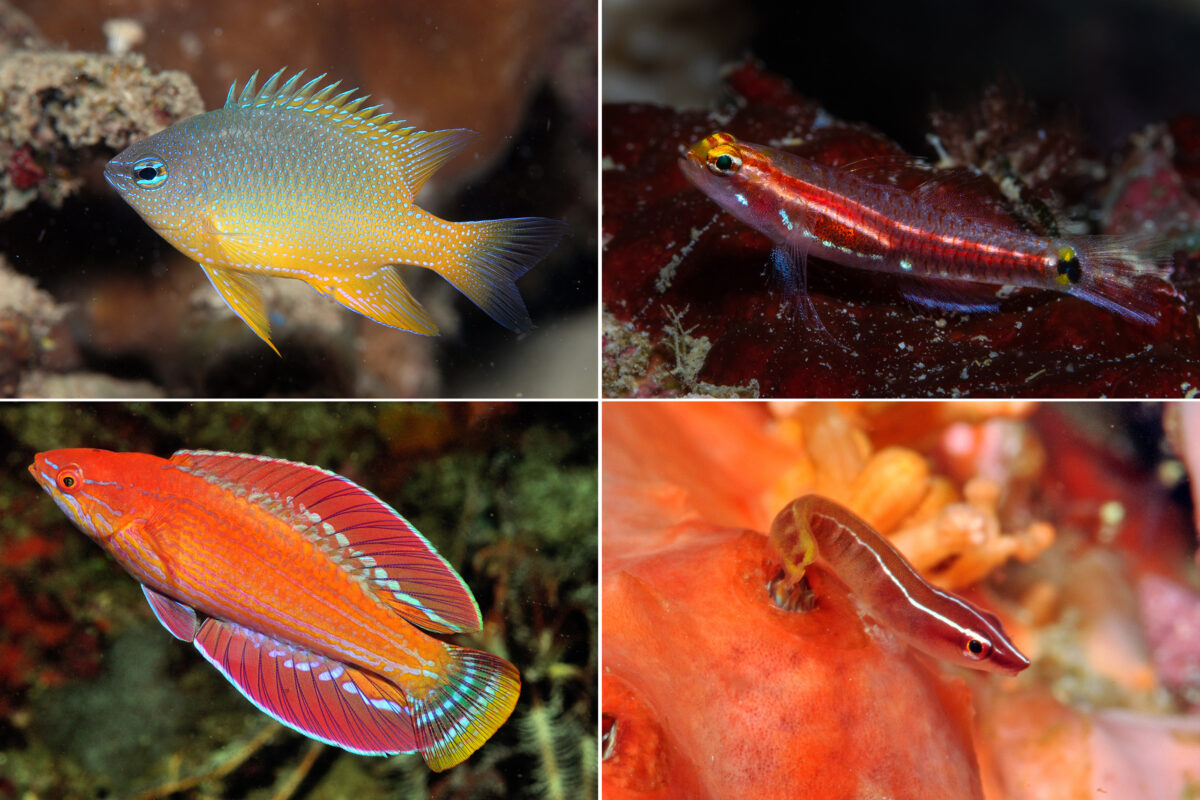
And honestly—it’s intoxicating. There’s nothing quite like it. When you come across something you’ve never seen before, and you know the species so well that you can instantly recognize it as new—it’s pure adrenaline. Of course, you need to get good photos and a specimen, which is often the hard part. But then you bring it back, work with Gerry, and eventually get to the naming process, which is always fun.
Sometimes we name new species after local political leaders—like a bupati—to encourage conservation support. Other times it’s a donor, the place where we found it, or a local term. We try to balance scientific recognition with practical impact.
For me, it’s more than science—it’s a hobby and a passion. I have to do a few species discovery dives a year just to stay sane. I get twitchy otherwise.
Mongabay: When you say “deep diving,” how deep are we talking?
Mark Erdmann: A lot of the new discoveries happen in the 50 to 70 meter range. That’s where I draw the line—70 meters is my self-imposed limit because of oxygen toxicity risks with regular air. But there’s still a lot of biodiversity waiting to be discovered in that range. It’s more than enough to keep me busy.
Mongabay: Do you have a favorite story you’d like to share?
Mark Erdmann: About new species? Sure, I’ve got plenty. One that stands out happened early on during our exploration of West Papua. Gerry Allen had gotten me interested in a group of fish called tilefish. They’re fascinating—usually found below 40 meters, and they build these massive rubble mounds where small social groups live together. Not much is known about them, but you’ll find anywhere from two to a dozen individuals living in these engineered mounds.
We’d already described a couple of new tilefish species when we were diving in the Triton Bay area of Kaimana. I was down deep on a dive—without a camera but with a spear—when I came across an absolutely stunning tilefish I’d never seen before. It had the usual blue and red coloration like one we’d named after the legendary scientist Jack Randall—but this one also had tiger-like stripes.
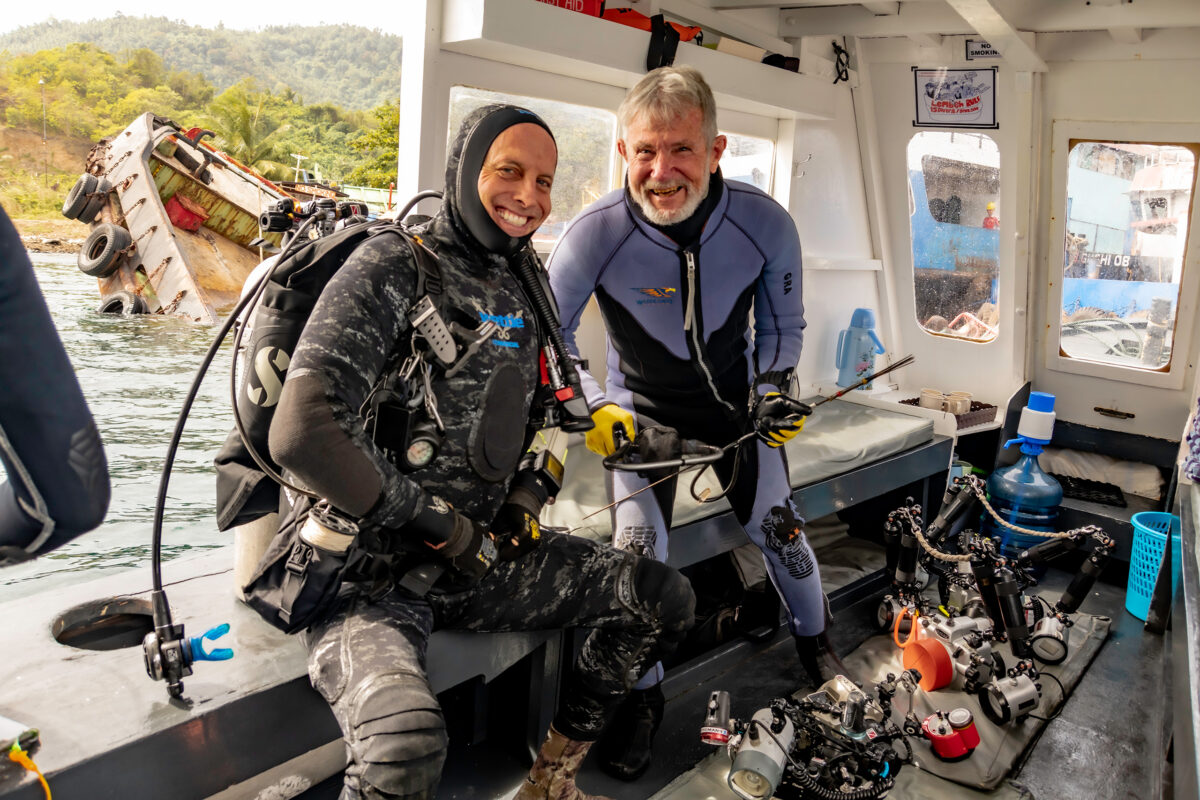
I was blown away. I tried to spear one and missed. I had over an hour of decompression ahead of me, so I surfaced, excited, and told Gerry about it. He looked at me and said, “You had nitrogen narcosis! You imagined it.” I insisted I hadn’t, and he challenged me: “Okay—if it’s real, go back and get one.”
So I convinced him to let me take his camera and went back down. I saw a couple of them, but they darted into the rubble every time I got close. Again, I ended up with more than an hour of decompression and no photos to show for it. I surfaced around 1 p.m., frustrated, and Gerry still didn’t believe me. We only had that one day at the site before moving on.
I really shouldn’t have done a third deep dive, but I was determined. I went back down—70 meters deep—for a third time that day, and this time I managed to spear three of them. I didn’t take the camera; I just needed proof. With the specimens in a bag, I began what would be a 95-minute decompression.
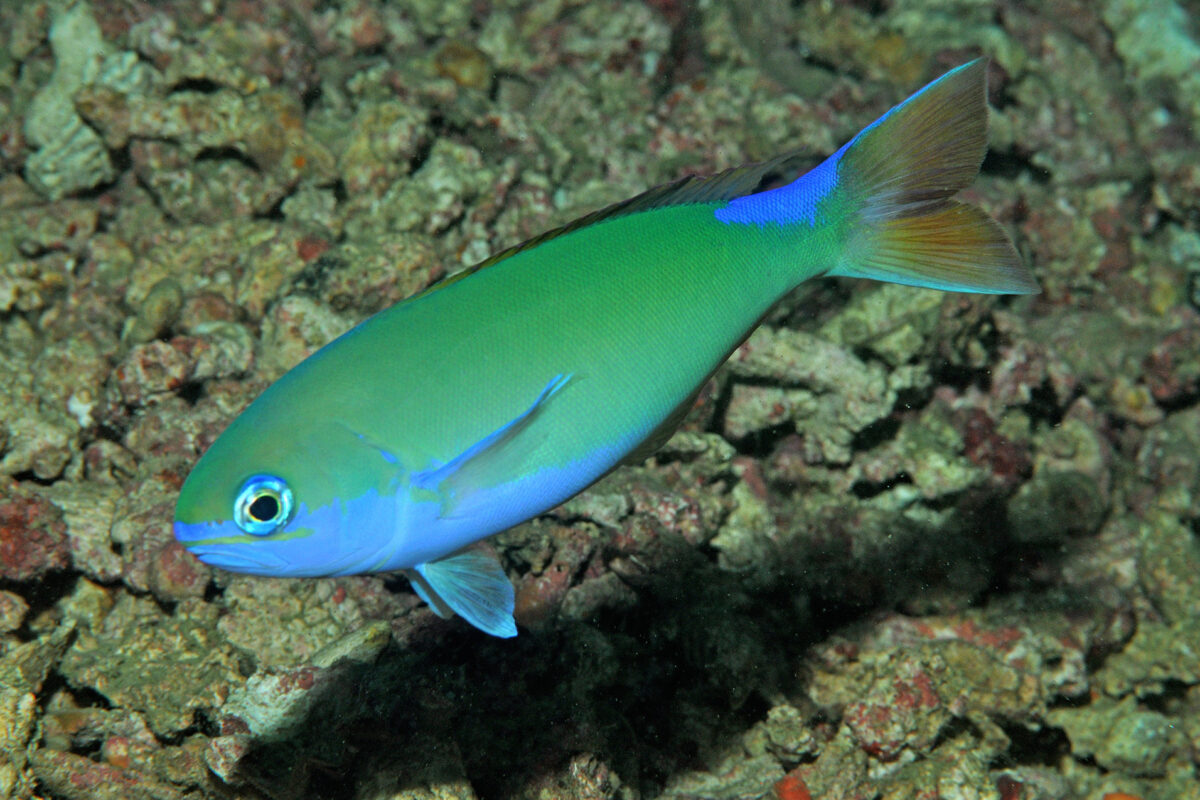

But as I was decompressing, I watched in horror as their stripes began to fade. By the time I got to the surface, I was sure they’d look like the ordinary Randall’s tilefish. I nearly considered surfacing early and risking decompression sickness, but I stayed the course.
Fortunately, once we applied formalin to preserve them, the stripes reappeared. Gerry finally believed me—and named the species after me in recognition of the ordeal. That’s the kind of commitment you sometimes need to discover and document new species.
Mongabay: You mentioned earlier diving in muddy mangroves. Have you ever had a close encounter with a saltwater croc?
Mark Erdmann: Yes—several, actually. Most remarkably, I’ve encountered saltwater crocodiles at depths of 60 to 70 meters. Both times were in the Triton Bay area of Kaimana. I’d be deep on a dive, swimming along, and suddenly there’d be a huge crocodile in front of me. We’d spot each other, and then it would swim off. They clearly didn’t expect a human down there—especially a bubble-blowing one.
I’ve never had a crocodile come toward me, and both encounters ended without issue. But I had no idea they went that deep until those experiences.
Outside of those incidents, I haven’t encountered crocs in the water directly. That said, I’ve done a lot of drone and helicopter surveys over Raja Ampat and seen plenty of crocodiles in the mangroves. In hindsight, when I think about the early days of exploring Raja with Max Ammer—some of the places we swam and dived under the assumption that crocs were no longer there—it makes me shudder a bit.
Today, crocodile sightings in those same areas are relatively common, and there have even been tourist attacks. So while I never had an incident, I’m quite certain that on several occasions, I was being watched… I just didn’t know it at the time.
Mongabay: Do you have a favorite spot in Raja Ampat?
Mark Erdmann: Yeah, I have a few. But overall, I think northwestern Waigeo—particularly Wayag—is still very, very special to me. I remember the first time I visited Raja Ampat in 2001, I was traveling with Max Ammer. We’d loaded up his little expedition boat with a compressor, tanks, a cook, and some food, and headed up to Wayag, where we camped on a small beach for a week.
I was blown away by the natural beauty. But what struck me even more was how many destructive activities were happening there. It was a hotspot for illegal fishing—shark finning, blast fishing, cyanide fishing. Every little bay had Sulawesi boats engaged in something damaging, and it broke my heart to see this happening in such a pristine place.

It actually brought me back to my time in South Sulawesi during my PhD, when many of my neighbors were shark finners. I remembered how they used to talk about this magical place in Papua with mushroom-shaped islands. At the time, I didn’t know where they meant. And then suddenly in 2001, there I was—sitting in that very place, surrounded by those same boats.
We learned on that trip that Wayag was owned under customary tenure by just two small Kawai communities. They had a massive marine territory, including Wayag, Kawe and the Equator Islands—an enormous area for such a small population. It struck me as a unique opportunity. These communities didn’t rely heavily on the area for food; they needed only a fraction of the marine territory they owned to feed themselves. So I got this “crazy” idea that it could become a model marine protected area (MPA).
At the time, colleagues at TNC and elsewhere said it would never work—it was too remote, too complicated and too expensive to consider. But I spoke with the Kawai people anyway. They were incredibly supportive. Wayag was sacred to them, and they hated seeing the outside boats pillaging it. They were enthusiastic about becoming the rangers themselves. And for a while, that MPA became one of our most successful in Raja Ampat—passionately protected by the local community.
Sadly, as its beauty gained national attention, the Ministry of Marine Affairs and Fisheries stepped in and designated it a national MPA. That effectively stripped the Kawai of management control. In my view, it really needs a rethink—decentralizing governance would be a better approach. Still, Wayag remains incredibly dear to me. It was the site of the world’s first documented reef manta ray nursery. It’s just… God’s country. Every time I’m there, I’m in awe.
Mongabay: What gives you hope when it comes to marine conservation?
Mark Erdmann: I’m generally an ocean optimist. Despite all the challenges, I see plenty of reasons to stay hopeful.
For one, Raja Ampat itself is proof. Even with issues like overtourism and the recent mining controversy—which has thankfully been halted—the reefs today are healthier than they were when I first dove there in 2001. And that wasn’t rocket science. It happened because we got the communities on board. We gave them ownership and support. The ocean did the rest. It has an incredible capacity to heal, if we just give it the chance.
Another source of hope is how the Indonesian public responded to the recent mining threat in Raja Ampat. I was envisioning the need for an international pressure campaign, but it turned out that domestic outrage alone stopped the project. That kind of grassroots, national-level conservation momentum is powerful.
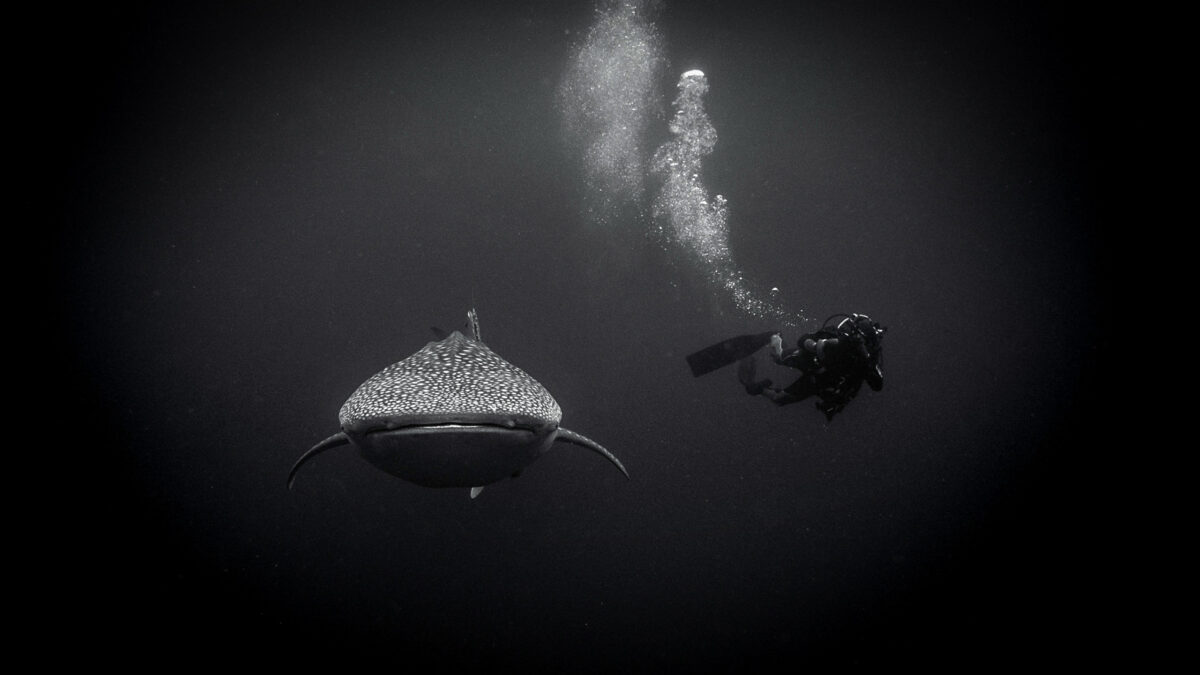
Finally, the young people in Indonesia inspire me more than anything. They’re smart, passionate, and skilled. They use social media constructively and are constantly launching new initiatives. Sure, not all of them will succeed—but the volume and energy of what’s happening is remarkable. Every week I hear about some 23-year-old starting a new conservation project, and it just fills me with optimism.
So, yeah—I’m hopeful. You have to be. The ocean can come back if we let it. And I believe the next generation is up for the task.
Mongabay: On the topic of recovery, I’ve read that the reefs and corals in Raja Ampat have a higher thermal maximum—suggesting they may be more resilient. Is that accurate?
Mark Erdmann: Yes, that’s broadly true. Back in the early days of our work in Raja Ampat, we undertook some fairly cutting-edge science for the time. We placed temperature loggers throughout Raja and across the wider Bird’s Head region of West Papua. What we discovered is that Raja’s reef systems are incredibly diverse in terms of thermal exposure. You’ve got live corals that regularly experience temperatures ranging from 19°C to 36°C—and those extremes might only be 500 meters apart.
Take Cape Kri, for example: corals down to 40 meters are regularly bathed in cold water upwellings that drop temperatures to 19°C. But if you go up to the reef flat in front of a place like Kri Eco Resort, that same reef is isolated during low tides and the temperature spikes daily to 36°C.
On top of that, Raja has these hot, salty lagoon systems—almost like marine lakes—that are constantly above 30°C and still support healthy coral communities. So what we think is happening is that the corals here are naturally pre-adapted to a wide range of thermal conditions.
There’s also increasing recognition that it’s not just the coral species that matter—it’s their symbiotic algae, the zooxanthellae. We used to think there was just one kind, but now we know there’s a whole suite of them, each with different temperature tolerances. Raja appears to host an especially diverse range of these symbionts, which likely contributes to its corals’ resilience.
Up until this past year, Raja almost never experienced significant coral bleaching. When bleaching did occur, it was typically minor and short-lived. But this last year—2023 into 2024—was different. It was the worst global coral bleaching event in recorded history, affecting 84% of the world’s reefs. Raja didn’t escape. Some places, like the eastern Dampier Strait, experienced near-total bleaching.
Whether those reefs will fully recover is still an open question. It’ll take a year or more to know for sure. Some areas already look much better—others, less so. Still, I’d say Raja remains a globally significant stronghold for coral reef resilience, and hopefully one that can continue to adapt to future stressors.
Mongabay: Is there any advice you’d give to someone looking to follow in your footsteps—or at least get involved in conservation?
Mark Erdmann: I think the most important thing is simple: follow your passion. That’s what’s guided me, and it’s what keeps me going. But more than that—get out there. I get a lot of messages from people who want to help but are sitting comfortably in their homes in Germany or the U.S., hoping to contribute to coral conservation remotely. While there’s value in that, real impact often comes from being on the ground—being present in the places where the work needs to happen.

That doesn’t always mean moving abroad. There are countless ways to make a difference: supporting local organizations, engaging in science communication, raising awareness, or applying your skills in data science, education, or policy. And to be honest, places like Indonesia are increasingly rich in local conservation talent. They don’t necessarily need outsiders—but they do welcome committed allies.
So my advice? Don’t wait for the perfect opportunity or job listing. Just start. Volunteer. Dive into fieldwork. Learn a local language. Build relationships. If you’re sincere and persistent, the path will open up.
Mongabay: What can the average person do at home to support marine conservation? That could be things like reducing seafood consumption, wildlife-friendly practices, or anything else you’d recommend.
Mark Erdmann: Yeah, that’s a good one—and I think you hit on one of the big issues, which is that every decision we make as consumers has an environmental impact. The challenge is, it’s not always obvious which choices are the right ones. Seafood is a perfect example of that. It’s such an opaque industry—there are hundreds of species, and even the same species can be harvested sustainably in one country and unsustainably in another. That makes it very hard for the average consumer to navigate.
Still, I think it’s worth trying. Educate yourself, be as informed as possible, and aim to be the best consumer you can be.
Beyond consumption, I do think marine tourism can be powerful—when done right. I’m not a fan of mass tourism, which often causes more harm than good. But in the right contexts, tourism dollars can replace far more extractive industries—whether that’s mining, logging, or overfishing. So, I encourage people to consider dive or snorkeling trips, but do your homework. Look for operations that genuinely benefit local communities and protect ecosystems—not just ones that use the word “eco” in the name.
And of course, there are many other ways to get involved. Support NGOs doing meaningful work. Sign petitions. Share information. Even small donations can make a difference. Stay informed and engaged. And when you feel called to act—act.




